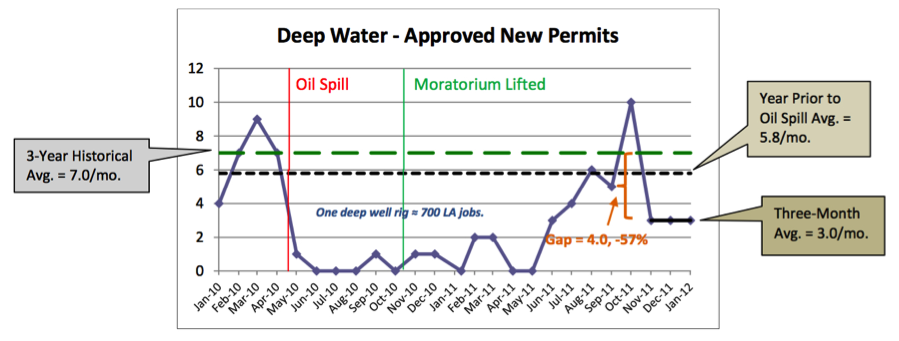Gas prices are on the rise, but the Obama administration continues its policy of slow-walking drilling permits in the Gulf of Mexico. Recently, Greater New Orleans, Inc. (GNO) released its monthly report on the status of oil and gas permits in the Gulf of Mexico—and the numbers help explain why gas prices are up 80% since President Obama’s inauguration.
The Gulf Permit Index shows that since November 2011, an average of only 3 deepwater permits have been issued each month. This is a 57 percent reduction from the historical average of 7 deepwater permits each month over the past three years:
Shallow water permits, although a considerably simpler operation than deepwater, have also decreased notably. Since November 2011, an average of 4.7 shallow water permits have been issued each month, representing a 68 percent decrease from the historical average of 14.7 new shallow water well permits each month:
No less important a measure of the impact of governmental intervention in offshore drilling is the average time it takes to approve each new permit, as well as the number of permits that ultimately receive approval. Data from GNO and the federal government’s offshore drilling regulatory agencies shows that the approval for an offshore drilling plan now takes 31 days longer—an increase of 52 percent from the historical average of 60.6 days—and in 2011 it took 48 days longer. That is almost 80 percent greater than the historical average:
Perhaps most telling of the reality in the Gulf is the number of permits that actually get approval. In the year to date, an average of 23 percent of drilling plans have been approved, a 69 percent reduction from the historical average of 73.4 percent. In 2011, the average number of approved plans was 34, which is a 53 percent decrease from the historical average. Instead of increasing in the time since the Gulf moratorium, exploration in the Gulf is continuing on a negative trend downward:
Restricting today’s supply of oil and gas from the Outer Continental Shelf (OCS) will have a significant impact on the United States’ future energy outlook. According to the Bureau of Ocean Energy Management, the administration’s offshore drilling regulatory agency, the OCS contains 86 billion barrels of technically recoverable oil and 420 trillion cubic feet of technically recoverable natural gas. Only 2 percent of offshore areas are currently leased for production, however, and large offshore drilling projects often take years to plan and build the infrastructure to support the operation. Considering that these significant impediments already exist, adding further layers of bureaucracy in the form of slower permitting processes and additional environmental regulations will undoubtedly factor into businesses’ decisions to operate in the Gulf.
Source for charts: Greater New Orleans Inc., Gulf Permit Index as of January 31, 2012, http://gnoinc.org/wp-content/uploads/GPI%2B-2012.02.02.pdf.
